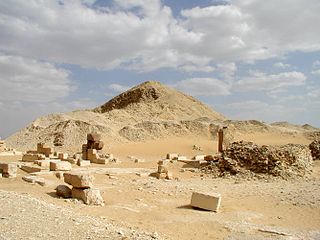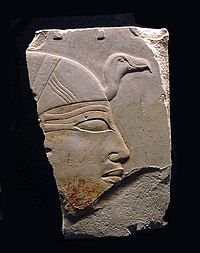Teti, less commonly known as Othoes, sometimes also Tata, Atat, or Athath in outdated sources, was the first king of the Sixth Dynasty of Egypt. He was buried at Saqqara. The exact length of his reign has been destroyed on the Turin King List but is believed to have been about 12 years.

Pepi II Neferkare was a pharaoh of the Sixth Dynasty in Egypt's Old Kingdom who reigned from c. 2278 BC. His second name, Neferkare (Nefer-ka-Re), means "Beautiful is the Ka of Re". He succeeded to the throne at age six, after the death of Merenre I.

Pepi I Meryre was an ancient Egyptian pharaoh, third king of the Sixth Dynasty of Egypt, who ruled for over 40 years at the turn of the 24th and 23rd centuries BC, toward the end of the Old Kingdom period. He was the son of Teti, the founder of the dynasty, and ascended the throne only after the brief intervening reign of the shadowy Userkare. His mother was Iput, who may have been a daughter of Unas, the final ruler of the preceding Fifth Dynasty. Pepi I, who had at least six consorts, was succeeded by his son Merenre Nemtyemsaf I, with whom he may have shared power in a coregency at the very end of his reign. Pepi II Neferkare, who might also have been Pepi I's son, succeeded Merenre.

Merenre Nemtyemsaf was an Ancient Egyptian pharaoh, fourth king of the Sixth Dynasty. He ruled Egypt for six to 11 years in the early 23rd century BC, toward the end of the Old Kingdom period. He was the son of his predecessor Pepi I Meryre and queen Ankhesenpepi I and was in turn succeeded by Pepi II Neferkare who might have been his son or less probably his brother. Pepi I may have shared power with Merenre in a co-regency at the very end of the former's reign.

Merenre Nemtyemsaf II was an ancient Egyptian pharaoh, the sixth and penultimate ruler of the 6th Dynasty. He reigned for 1 year and 1 month in the first half of the 22nd century BC, at the very end of the Old Kingdom period. Nemtyemsaf II likely ascended the throne as an old man, succeeding his long-lived father Pepi II Neferkare at a time when the power of the pharaoh was crumbling.

Khentkaus II was a royal woman who lived in ancient Egypt. She was a wife of Egyptian king Neferirkare Kakai of the Fifth Dynasty. She was the mother of two kings, Neferefre and Nyuserre Ini.

The South Saqqara Stone is the lid of the sarcophagus of the ancient Egyptian queen Ankhesenpepi I, which was inscribed with a list for the reigns of the pharaohs of the 6th Dynasty from Teti, Userkare, Pepi I, Merenre to the early years of Pepi II under whom the document was likely created. It is essentially an annal document which records events in each year of a king's reign; unfortunately, it was reused in antiquity for Ankhesenpepi I's burial and many of its invaluable inscriptions have been erased.

Neferkare Neby was an ancient Egyptian pharaoh of the Seventh or Eighth Dynasty during the early First Intermediate Period. According to Egyptologists Jürgen von Beckerath and Darrell Baker, he was the fourth king of the Seventh dynasty, as he appears as the fourth king in the Abydos King List within the list of kings assigned to this dynasty.
Iput I was a queen of ancient Egypt, a daughter of King Unas, the last king of the Fifth Dynasty of Egypt. She married Teti, the first Pharaoh of the Sixth Dynasty of Egypt. Their son was Pepi I Meryre. She possibly ruled as regent for her son Pepi I.
Ankhesenpepi I was a queen consort during the Sixth Dynasty of Egypt.
Neith was an ancient Egyptian queen consort, one of the principal queens of the Old Kingdom pharaoh Pepi II Neferkare, who ruled. Queen Neith was named after goddess Neith.
The pyramid of Pepi I is the pyramid complex built for the Egyptian pharaoh Pepi I of the Sixth Dynasty in the 24th or 23rd century BC. The complex gave its name to the capital city of Egypt, Memphis. As in the pyramids of his predecessors, Pepi I's substructure was filled with vertical columns of hieroglyphic texts, Pyramid Texts. It was in Pepi I's pyramid that these texts were initially discovered in 1880 by Gaston Maspero, though they originated in the pyramid of Unas. The corpus of Pepi I's texts is also the largest from the Old Kingdom, comprising 2,263 columns and lines of hieroglyphs.
Iput was an ancient Egyptian queen consort of the Sixth Dynasty, a sister and wife of Pepi II.
Ankhesenpepi III was an ancient Egyptian queen of the Sixth Dynasty as a consort of Pepi II, who was probably her uncle. She was a daughter of Merenre Nemtyemsaf I and was named after her grandmother, Ankhesenpepi I.

Ankhesenpepi IV was an ancient Egyptian queen, a wife of Pharaoh Pepi II of the Sixth Dynasty. She was the mother of a crown prince Neferkare. Pepi II also had several other wives.
Udjebten or Wedjebten was an ancient Egyptian queen consort, a wife of Pharaoh Pepi II of the Sixth Dynasty.
Nubwenet was an ancient Egyptian queen consort, a wife of Pharaoh Pepi I of the 6th dynasty.
Nedjeftet is a queen mentioned on reliefs discovered near the pyramid complex of Pepi I. She was a wife of Pepi. Her name was also that of the 20th nome, later known as the Herakleopolis nome, in Upper Egypt; it is possible her family came from there and the marriage was to strengthen the king's position as opposed to the local lords.
Khuit II was a wife of King Teti, the first pharaoh of the Sixth Dynasty of Egypt.
Meritites IV was a queen consort from the Sixth Dynasty. She was believed to be a wife of Pepi I Meryre, but her title of King's Daughter of his body of Pepy-Mennefer (s3t-niswt-nt-kht.f-ppy-mn-nfr) is now understood to indicate that she was a daughter of Pepi I Meryre and wife of a king Neferkare, presumably Pepi II. One more evidence for that theory is that her name means "Beloved of her father".










